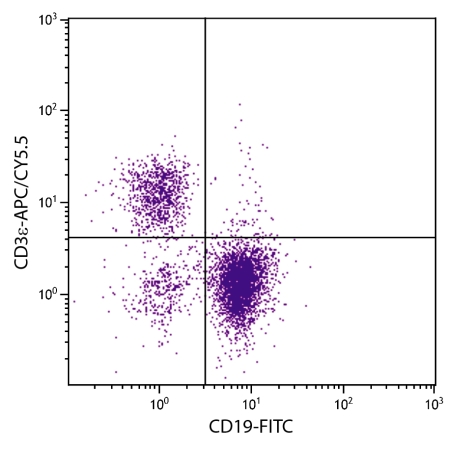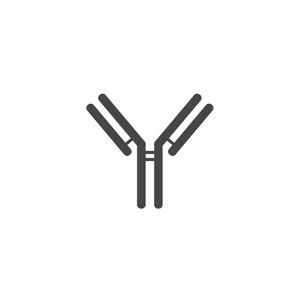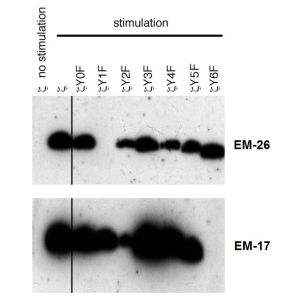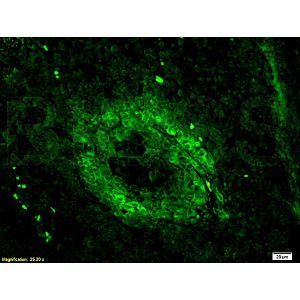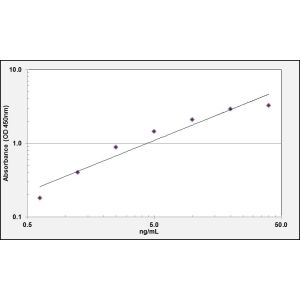Mouse CD3e Antibody : APC/Cy5.5
Cat# OASB01666
Size : 0.1mg
Marca : Aviva Systems Biology
| Datasheets/Manuals | Printable datasheet for Mouse CD3e Antibody : APC/Cy5.5 (OASB01666) |
|---|
| Tested Species Reactivity | Mouse |
|---|---|
| Predicted Species Reactivity | Mouse |
| Clonality | Monoclonal |
| Clone | 500-A2 |
| Isotype | IgG |
| Host | Hamster |
| Conjugation | APC|Cyanine 5.5 |
| Application | FC |
| Additional Information | Description: CD3 epsilon, a member of the immunoglobulin superfamily of cell surface receptors, is comprised of five invariable chains ranging in size from 16-28 kDa and is closely associated with the T cell antigen receptor (TCR). CD3 epsilon is expressed on all T cells of all mouse strains. CD3 plays a major role in signaling during antigen recognition, leading to T-cell activation. 500-A2 recognizes an epitope on the 25 kDa epsilon chain of the CD3/TCR complex of mouse strains tested. |
| Reconstitution and Storage | Store at 2-8C |
| Immunogen | Immune complexes isolated from C6VL-BS thymoma cells |
| Concentration | 0.1 mg/mL |
| Specificity | CD3e |
| Characterization | To insure acceptable performance, each batch of product is tested by flow cytometry to conform to thecharacteristics of a standard reference. |
| Warning | Reagents contain sodium azide. Sodium azide is very toxic if ingested or inhaled. Avoid contact with skin,eyes, or clothing. Wear eye or face protection when handling. If skin or eye contact occurs, wash withcopious amounts of water. If ingested or inhaled, contact a physician immediately. Sodium azide yieldstoxic hydrazoic acid under acidic conditions. Dilute azide- containing compounds in running water beforediscarding to avoid accumulation of potentially explosive deposits in lead or copper plumbing. |
| Dilution | Flow Cytometry: Fluorescein conjugate Biotin conjugate R-phycoerythrin conjugate Allophycocyanin conjugate Spectral Red conjugate Cyanine 5 conjugate APC-CY5.5 <= 3 ug/106 cells <= 3 ug/106 cells <= 1 ug/106 cells <= 1 ug/106 cells <= 1 ug/106 cells <= 1 ug/106 cells <= 1 ug/106 cells |
| Application Info | Identification and enumeration of CD3+ cells by flow cytometry 1, Immunoprecipitation 2, In vitro activation of T cells 2, 3, 4 |
| Other Applications Data | Since applications vary, you should determine the optimum workingdilution of the product that is appropriate for your specific need. |
| Storage | - The purified (UNLB) antibody is supplied as 0.5 mg of purified immunoglobulin in 1.0 mL of 100 mMborate buffered saline, pH 8.2. No preservatives or amine- containing buffer salts added. Store at 2- 8 C - The fluorescein (FITC) conjugate is supplied as 0.5 mg in 1.0 mL of PBS/NaN3. Store at 2- 8 C - The biotin (BIOT) conjugate is supplied as 0.5 mg in 1.0 mL of PBS/NaN3. Store at 2- 8 C - The R- phycoerythrin (R- PE) and allophycocyanin (APC) conjugates are supplied as 0.1 mg in 1.0 mLof PBS/NaN3 and a stabilizing agent. Store at 2- 8 C. Do not freeze! - The Spectral Red (SPRD) and Allophycocyanin- Cyanine 5.5 (APC- CY 5.5) conjugates aresupplied as 0.1 mg in 1.0 mL of PBS/NaN3 and a stabilizing agent. Store at 2- 8 C. Do not freeze! - The low endotoxin, azide- free (LE/AF) antibody is supplied as 0.5 mg purified immunoglobulin in 1.0 mLof PBS. Aliquot and store at or below - 20 C - The Cyanine 5 (CY 5) conjugate is supplied as 0.1 mg in 1.0 mL of PBS/NaN3. Store at 2- 8 C - With the exception of the low endotoxin, azide- free product, the vials should be stored at 2- 8 C Conjugated forms should not be frozen and should be protected from prolonged exposure to light Aliquot and freeze the low endotoxin, azide- free product at - 20 C immediately upon receipt. Eachreagent is stable for the period shown on the bottle label if stored as directed. |
| Reference | 1. Portoles, P., J. Rojo, A. Golby, M. Bonneville, S. Gromkowski, L. Greenbaum, C. A. Janeway, Jr., D. B. Murphy, and K. Bottomly. 1989. J Immunol. 142:4169 2. Allison, J.P., W.L. Havran, M. Poenie, J. Kimura, L. DeGraffenreid, S. Ajami, G. Duwe, A. Weiss, and R. Tsien. 1988. The T- Cell Receptor,UCLA Symposia, 73rd ed. Kappler, J. and M. Davis eds. 33- 45 3. Havran, W.L., M. Poenie, J. Kimura, R. Tsien, A. Weiss, and J.P. Allison. 1987. Nature 330:170- 173 4. Duke, R.C., J.J. Cohen, S.A. Boehme, M.J. Lenardo, C.D. Surh, H. Kishimoto, and J. Sprent. 1995. In: Currents Protocols in Immunology J. Coligan, A. Kruisbeek, D. Margulies, E.M. Shevach, and W. Strober, eds. John Wiley & Sons, New York, pp. 3.17.1- 3.17.33. |
|---|---|
| Gene Symbol | CD3E |
| Gene Full Name | T-cell surface glycoprotein CD3 epsilon chain |
| Alias Symbols | CD3, T3e, AI504783, CD3epsilon |
| NCBI Gene Id | 12501 |
| Protein Name | T-cell surface glycoprotein CD3 epsilon chain |
| Uniprot ID | P22646 |
| Protein Accession # | NP_031674.1 |
| Nucleotide Accession # | NM_007648.4 |




